Lockheed F-94 Starfire
| F-94 Starfire | |
|---|---|
 | |
| A U.S. Air Force F-94B Starfire in flight. | |
| Role | All-weather interceptor |
| National origin | United States |
| Manufacturer | Lockheed Corporation |
| First flight | 16 April 1949 |
| Introduction | May 1950 |
| Retired | 1958 USAF 1959 ANG |
| Primary users | United States Air Force Air National Guard |
| Number built | 855 |
| Unit cost | US$196,248 (F-94B)[1] |
| Developed from | Lockheed T-33 Shooting Star |
The Lockheed F-94 Starfire was a first-generation jet aircraft of the United States Air Force. It was developed from the twin-seat Lockheed T-33 Shooting Star in the late 1940s as an all-weather, day/night interceptor. The aircraft reached operational service in May 1950 with Air Defense Command, replacing the piston-engined North American F-82 Twin Mustang in the all-weather interceptor role.
The F-94 was the first operational USAF fighter equipped with an afterburner and was the first jet-powered all-weather fighter to enter combat during the Korean War in January 1953. It had a relatively brief operational life, being replaced in the mid-1950s by the Northrop F-89 Scorpion and North American F-86D Sabre. The last aircraft left active-duty service in 1958 and Air National Guard service in 1959.
Design and development

Built to a 1948 USAF specification for a radar-equipped interceptor to replace the aging F-61 Black Widow and North American F-82 Twin Mustang, it was specifically designed to counter the threat of the USSR's new Tupolev Tu-4 bombers (reverse-engineered Boeing B-29). The Curtiss-Wright XF-87 Blackhawk had been designated to be the USAF first jet night fighter, but its performance was subpar, and Lockheed was asked to design a jet night fighter on a crash program basis.[2] The F-94 was derived from the TF-80C (later T-33A Shooting Star) which was a two-seat trainer version of the F-80 Shooting Star. A lengthened nose area with guns, radar, and automatic fire control system was added. Since the conversion seemed so simple, a contract was awarded to Lockheed in early 1949, with the first flight on 16 April 1949. The early test YF-94s used 75% of the parts used in the earlier F-80 and T-33As.[3]
The fire control system was the Hughes E-1, which incorporated an AN/APG-33 radar (derived from the AN/APG-3, which directed the Convair B-36's tail guns) and a Sperry A-1C computing gunsight.[4] This short-range radar system was useful only in the terminal phases of the interception. Most of the operation would be directed using ground-controlled interception, as was the case with the earlier aircraft it replaced.
The added weight of the electronic equipment required a more powerful engine, so the standard J-33 turbojet engine, which had been fitted to the T-33A, was replaced with an afterburning Allison J33-A-33. The combination reduced the internal fuel capacity. The F-94 was to be the first US production jet with an afterburner. The J33-A-33 had standard thrust of 4,000 pounds-force (18 kN), and with water injection this was increased to 5,400 pounds-force (24 kN) and with afterburning a maximum of 6,000 pounds-force (27 kN) thrust.[3] The YF-94A's afterburner had many teething problems with its igniter and the flame stabilization system.[2]
Production versions

The initial production model was the F-94A, which entered operational service in May 1950. Its armament was four 0.50 in (12.7 mm) M3 Browning machine guns mounted in the fuselage with the muzzles exiting just behind the radome. Two 165 US Gallon (1,204 litre) drop tanks, as carried by the F-80 and T-33, could be carried beneath the wingtips. Alternatively, these could be replaced by 1,000 lb (454 kg) bombs, giving the aircraft a secondary fighter bomber role.[4][5] 109 were produced. The F-94A was in operational service for only a brief time as it was originally built, and was not received well by its aircrews. Primarily, this was due to the unreliability of its J33 engine, which caused many ground aborts and was deemed by the crews to be unsafe. The aircraft was judged as unstable and hard to maneuver at high altitude by its pilots. The pilot and radar operator found that the cockpit was too narrow for them to be able to get in and out of the aircraft quickly during alerts and scrambles. The clearance for the ejection seats was too small, resulting in several tragic accidents during emergency ejections.[6]

The subsequent F-94B, which entered service in January 1951, was outwardly virtually identical to the F-94A. The Allison J33 turbojet had a number of modifications made, which made it a very reliable engine; the pilot was provided with a more roomy cockpit and the canopy was replaced by a canopy with a bow frame in the center between the two crew members, as well as a new Instrument Landing System (ILS). 356 of these were built. It proved in service to be a very reliable aircraft with relatively few problems. As they replaced the F-94As in service with the active-duty squadrons, the older models were sent to Lockheed to be re-engined and modified to F-94B standards. These upgraded F-94A/B aircraft were also modified with a pod under each wing for two additional 0.50 in (12.7 mm) machine guns, bringing the total to eight. These aircraft were then passed along to Air National Guard units where they served until the end of the 1950s.[6]
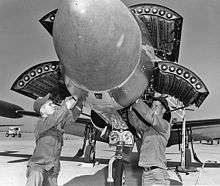
The F-94C Starfire was extensively modified from the early F-94 variants. In fact, it was initially designated F-97, but it was ultimately decided to treat it as a new version of the F-94. USAF interest was lukewarm, so Lockheed funded development themselves, converting two F-94B airframes to YF-94C prototypes for evaluation. To improve performance, a completely new, much thinner wing was designed, along with a swept tail surface. The J33 engine was replaced with a more powerful Pratt & Whitney J48, a license-built version of the afterburning Rolls-Royce Tay, which dramatically increased power, producing a dry thrust of 6,350 pounds-force (28.2 kN) and approximately 8,750 pounds-force (38.9 kN) with afterburning.[3] The fire control system was upgraded to the new Hughes E-5 with an AN/APG-40 radar in a much larger nose. The guns were removed and replaced with all-rocket armament consisting of four groups of six rockets in a ring around the nose. The rockets were carried in four panels that could be hinged upwards and outwards for ground reloading. In flight these rockets were normally hidden aft of four fold-in doors that folded inwards for combat.
According to Lockheed test pilot Tony LeVier, the F-94C was capable of supersonic flight in a steep dive with afterburner engaged.[7]
The F-94C was the only variant to be officially named Starfire. With time, the entire F-94 family has adopted the name. The first production F-94C aircraft were delivered in July 1951, 387 examples being delivered before May 1954. The largest problem discovered in service was the nose-mounted rockets, which blinded the crew with their smoke and fire. The most severe problem associated with firing the nose-mounted rockets was that the exhaust could cause a flameout of the jet engine, which could lead to loss of the aircraft. Mid-wing rocket pods were added, holding 12 rockets apiece. Most of the time, the nose rockets were not fitted, and the mid-wing pod rockets were the sole armament. This version of the aircraft was extensively used within the Semi Automatic Ground Environment (SAGE) air defense system.
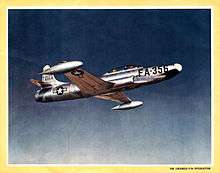
An F-94D model was proposed as a single-seat fighter bomber, with bombs and rockets under the wings. A single prototype was built, but the model was not accepted for production. The prototype was later used as a testbed for the 20 mm (0.79 in) M61 Vulcan cannon subsequently used on the F-104 Starfighter and many others.
Operational history
Air Defense Command
The primary user of the F-94 were the squadrons of Air Defense Command (ADC), eventually equipping 26 squadrons of interceptors. The first F-94As were assigned to the 325th Fighter-All Weather Group at McChord AFB and Moses Lake AFB, Washington.[8] It replaced the propeller-driven F-82F Twin Mustangs that were in use by its 317th, 318th, and 319th squadrons. The F-82s had been pressed into interceptor service in 1949 after the Soviet Union displayed the Tupolev Tu-4 strategic bomber, a reversed-engineered version of the B-29 Superfortress, some of which had landed and were impounded in the Soviet Far East during World War II. The F-82Fs proved to be an excellent day/night all-weather interceptor, with long range, but it lacked any logistics support which resulted in a chronic shortage of parts. The jet-powered F-94As, however, had shorter legs than the F-82s and relied more on Ground Control Interception Radar (GCI) sites to vector them to intruding aircraft.[6]

Once the 317th was equipped in the Pacific Northwest, ADC then re-equipped its 52d Fighter-All Weather Group at McGuire AFB, New Jersey[8] which also flew F-82Fs and provided air defense of the Northeastern United States. However, it was during this period that Air Defense Command began dispersing its Fighter-Interceptor squadrons away from their parent groups to individual bases. During 1950 and 1951, ADC sent F-94As to squadrons of the 56th Fighter Group[8] in the upper Midwest to replace its obsolete F-47 Thunderbolts, F-51 Mustangs, as well as F-80 Shooting Star and F-86A Sabre day jet interceptors.[6]
In March 1951, upgraded F-94Bs were received from Lockheed by the 33d Fighter Wing at Otis AFB, Massachusetts, replacing their F-86A Sabres,[9] although the last squadron of the wing didn't replace its Sabres until May 1952. Three Federalized Air National Guard units, the 121st FIS (DC ANG), 142nd FIS (Maine ANG), and 148th FIS (Pennsylvania ANG), received F-94Bs while they served on active duty during the Korean War call-up to defend the airspace over Washington, D.C. However, these F-94s were retained by the USAF when these ANG squadrons returned to State control in 1952. Also seven more squadrons received F-94Bs as part of the roll out from Lockheed.[6][9]
Three additional squadrons (84th, 436th, and 479th FIS) received F-94Bs in 1953, although these were passed down from squadrons receiving F-94Cs.[9] Beginning in the summer of 1951, the F-94Cs began coming off the production line, with six squadrons being equipped by May 1954. Five more squadrons were equipped in FY 54-55 which ended the production run for the interceptor by Lockheed.[6][10]
Far East Air Force
In the Pacific, Far East Air Force (FEAF) equipped three squadrons with F-94Bs, and Air Defense Command deployed the 319th Fighter-Interceptor Squadron to South Korea to provide a jet air-defense umbrella over the Seoul area.
The first shipment of F-94Bs arrived in Japan in March 1951, being assigned to the 339th Fighter-All Weather Squadron at Johnson Air Base. Also arriving was a mobile training unit from Chanute AFB, Illinois to provide transition training for the F-82G Twin Mustang pilots into the new jet interceptor. In May, F-94Bs began to re-equip the 68th FAWS at Itazuke Air Base, while rotating pilots and radar operators to Suwon Air Base in South Korea where they flew combat missions over North Korea with the F-82Gs as well as air defense alert over Seoul. In July, the 4th FAWS began receiving the F-94As at Naha Air Base, Okinawa. Training for the squadrons proceeded though the summer and in August, the first Fifth Air Force Operational Readiness Test was held by the 339th FAWS with the F-94. Various issues with the aircraft, as well as issues with the Ground Control Interception radar graded the test as "fair".[6]

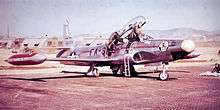
In early December 1951 the appearance of Communist MiG-15 jets over Seoul raised alarm bells at FEAF Headquarters. The only interceptors over Seoul were about six F-82Gs along with some Marine Grumman F7F Tigercats. FEAF ordered the 68th to move two F-94Bs to Suwon to supplement the F-82Fs. The Twin Mustangs along with the F7Fs would continue their armed reconnaissance and weather missions against North Korean targets, while the F-94s would fly interception missions over South Korea and the Yellow Sea. Care was taken to not fly the Starfires anywhere that a crash would allow the communists access to the wreck if it were shot down.[6]
In January 1952, ADC was ordered to deploy the 319th Fighter-Interceptor Squadron from the 25th Air Division at Larson AFB, Washington to Japan, and to relieve the 68th FIS at Itazuke. A detachment of the ADC squadron was sent to Misawa AB to fly air defense missions over Northern Honshu and Hokkaido against any intruding Soviet aircraft from Sakhalin Island or the Vladivostok area. At Suwon, the 68th had a total of fifty-eight interceptions during February during nighttime hours. It was in February 1952 that the first F-94 was lost in a night interception while pursuing an unknown aircraft over the Yellow Sea. The cause of the loss was unknown. However, a B-26 pilot observed an explosion in the air between the island of Taeyonp'yong-do and the city of Haeju in North Korea. A search was made for the aircraft and crew, which continued for almost three months. It was finally concluded the aircraft had crashed and broken up over the Yellow Sea, with the wreckage settling in deep water with the classified equipment lost at sea.[6]
In March 1952 the 319th FIS began flying operational missions at Suwon, providing Combat Air Patrols (CAPs) for B-29 Superfortress missions at night. The 68th was relieved and reassigned to Japan, but would remain on one-hour alert for possible combat duty over Korea. In June, the first F-94 contacts against enemy jets was made and the interceptor crews believed at the time that the communists were testing radar-warning equipment. On several occasions just when they were ready to fire on the enemy aircraft, it would start evasive action that indicated the MiGs were equipped with a form of warning radar (as the F-94s were).[6] Other intercepts would take place over North Korea and the F-94 was credited with several air-to-air victories, including the first jet-vs.-jet night victory against a MiG-15. One F-94 was listed as lost due to enemy action, six more to non-enemy causes on combat missions, two were declared as missing on a combat mission and three were lost in accidents.[11] One F-94 was lost when it slowed to 110 miles per hour (180 km/h) during pursuit of a Po-2 biplane.[12]
After the Armistice in Korea in June 1953, the F-94s continued to fly air defense missions over Japan and South Korea. Beginning in 1954, the F-86D Sabre began replacing it in operational service. By the end of 1954, the Starfires had been returned to the United States for Air National Guard duty.
Alaskan Air Command
Immediately after World War II ended, most of the Eleventh Air Force in Alaska was withdrawn, and its assets were concentrated at two bases, Ladd AFB near Fairbanks and Elmendorf AFB near Anchorage. With the advent of the Soviet Tu-4 and its possessing the Atomic Bomb, air defense assets were sent to Alaska to guard against a Soviet attack on the United States coming from Siberia. Chains of Ground Control Radar sites were established under Alaskan Air Command (AAC), the postwar successor to Eleventh Air Force, and P-61 Black Widows were sent in 1948 as long distance interceptor aircraft. The F-82H Twin Mustang replaced the war-weary P-61s in 1949.[13]
These propeller-driven interceptors were augmented in 1950 when the 449th Fighter-All Weather Squadron at Ladd AFB began receiving F-94As in mid-1950s.[6] The squadron was divided into the F-82 flight and the F-94 flight as the jet interceptors doubled the squadron in size.[14] In Anchorage, the 57th Fighter Group at Elmendorf AFB began sending its F-80C Shooting Stars back to the Continental United States in batches of four or five as they were replaced by the F-94As.[6] Elmendorf AFB, being located close to the Gulf of Alaska in the south had much more moderate weather than Ladd AFB, located in Central Alaska where winter temperatures often fell below -40 Fahrenheit. Hydraulic fluids would turn to jelly, and the engines in the jets would have starting problems. Extreme cold weather training for Air Force personnel assigned to Ladd AFB was mandatory in the event of an emergency ejection or even just being outside in the winter, losing a glove, and dropping a wrench or tool. Skin would freeze upon touching bare metal, and mechanics would have tools "welded" to their fingers at times.[6]
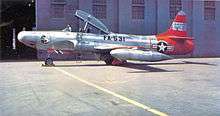
The 449th utilized its F-82Hs as long-range reconnaissance aircraft along the Siberian coastline and the Chukchi Peninsula. Also the F-82s were flown in a ground support role during maneuvers with the Army forces. They would also drop bombs on frozen rivers to break up ice flows.[14] For these missions, the F-94 was totally unsuitable and it also did not have the range for the long distance reconnaissance flights necessary to monitor the Siberian coast.[6] Alaska was divided into two areas, the northern part under the 11th Air Division, headquartered at Ladd AFB, and had control of the GCI sites in the northern half of the territory. The 57th Fighter Group, based at Elmendorf AFB, was responsible for everything south.[13] In April 1953, the 57th FIG was inactivated and the three squadrons F-94s at Elmendorf AFB became part of the 10th Air Division. Both the 449th FIS and the 57th FIG deployed the F-94s to advance airfields at Marks AFB, near Nome, along with King Salmon Airport and Galena AFB where it stood alert to respond to GCI intruder alerts for unknown aircraft detected intruding on Alaskan airspace.[6]
The F-82Hs at Ladd were retired in the summer of 1953 when due to lack of logistics support, the aircraft became too unreliable to keep in the air.[14] The 449th flew the F-94A until F-94Bs became available as hand-me-downs from Elmendorf AFB the 57th FIG was inactivated replaced by the 10th Air Division. There, the 10th AD received new F-86D Sabre Interceptors. The 449th at Ladd sent their F-94As back to the CONUS and Air National Guard Service. By the end of 1954, it also was being re-equipped with F-86Ds, with the last of the Starfires also being sent to the Air National Guard.[6]
Northeast Air Command
Northeast Air Command (NEAC) was a command formed in 1950 to administer US-controlled bases in the Maritime Provinces of Canada, that were under long-term lease going back to World War II. It was responsible for the defense of the northern approaches to North America and also to support transient aircraft of MATS and SAC, all of which came under the collective command and control of the 64th Air Division.[15]
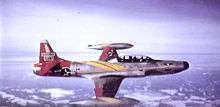
In 1952, F-94Bs were sent to the 59th Fighter-Interceptor Squadron at Goose AFB, Labrador from Otis AFB, Massachusetts, also a detachment of the 59th was sent to Thule AB, Greenland to provide air defense of the base, although it was still under construction to back up the DEW Line. Thule was a staging base at the time for the SAC B-36 Peacemaker intercontinental bomber, which would proceed from there in wartime to targets in the Soviet Union using the great circle route over the North Pole. This was both the first F-89 squadron assigned to Canada and also the first squadron assigned to NEAC.[6][16]
After the end of the Korean War, the 319th FIS, which was deployed from ADC to Japan in 1952, was transferred to NEAC in June 1953 and replaced the detachment of the 59th FIS at Thule.[16] The third and last F-94 squadron assigned to NEAC was the 61st Fighter-Interceptor Squadron, which moved from Selfridge AFB, Michigan to Ernest Harmon AFB, Newfoundland in August 1953.[16] Beginning in 1954, and continuing until 1957, the Starfires of NEAC were slowly replaced with versions of the F-89 Scorpion, although the Northrop interceptor didn't fully replace the Starfires until the 318th Fighter-Interceptor Squadron left Thule in April 1957.[6]
Keflavik Airport, Iceland, although controlled by Military Air Transport Service (MATS), received F-94Bs as part of the 82d Fighter-Interceptor Squadron in April 1953 It provided air defense of Iceland until being relieved in October 1954 when it was reassigned to Presque Isle AFB, Maine.[16] The Starfires were replaced by the 57th FIS and F-89C Scorpions.[6]
Retirement
The F-94A/B models were replaced in the active-duty inventory beginning in mid-1954 by a combination of the Northrop F-89C/D Scorpion and the North American F-86D Sabre interceptors.[17] They were sent to Air National Guard units where they replaced North American F-80C Shooting Stars and F-51D/H Mustangs, which in most cases marked the end of the line for the venerable Mustang in United States military service.[6] When sent to the ANG, the F-94As were sent to Lockheed for modification to F-94B standards and then returned to the ANG as B models. Also in the late 1950s, F-94Cs were passed along to the Air National Guard, supplementing the F-94A/B models. Eventually 22 ANG Fighter-Interceptor squadrons were equipped with the Starfire interceptor.[6]
The last F-94C was retired by the active-duty Air Force in November 1957 when the 319th Fighter-Interceptor Squadron at Bunker Hill Air Force Base, Indiana converted to the F-89J Scorpion interceptor.[6][16] The last F-94C Starfires were phased out of ANG service by the 179th Fighter-Interceptor Squadron at the Duluth Municipal Airport, Minnesota during the summer of 1959 when it converted to the F-89J Scorpion; the last aircraft being sent to AMARC in December 1959.[6]
Variants

- YF-94
- TF-80Cs converted into YF-94 prototypes, two built.[18]
- F-94A
- Initial production version, 109 built.[18]
- YF-94B
- One F-94A modified on the production line with new flight director, modified hydraulic systems, and two enlarged wingtip tanks.[18]
- F-94B
- Production model based on YF-94B, 355 built.[18][19][nb 1]
- YF-94C
- F-94Bs modified with Pratt and Whitney J48 engine, leading edge rocket pods, and swept tailplane, originally designated YF-97A, two modified.
- F-94C Starfire
- Production version of the YF-94C with longer nose, gun armament replaced with nose mounted rockets, and provision for underfuselage JATO rockets, originally designated F-97A, 387 built.[21]
- EF-94C
- Test aircraft for proposed reconnaissance variant
- YF-94D
- Prototype single-seat close support fighter version based on the F-94C, one partly built but construction was abandoned when program was cancelled.
- F-94D
- Production version of the YF-94D, 112 on order cancelled, none built.[22]
- YF-97A
- Original designation of the YF-94C.
- F-97A
- Original designation of the F-94C.
Operators
Aircraft on display

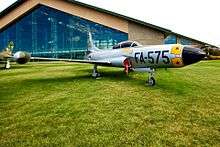
.jpg)
- YF-94A
- 48-356 – Air Force Flight Test Museum at Edwards Air Force Base in California. Formerly used as a gate guard at Lackland Air Force Base in San Antonio, Texas, currently in storage on Edwards AFB awaiting restoration and future display.[23]
- F-94A
- 49-2498 – National Museum of the United States Air Force at Wright-Patterson Air Force Base near Dayton, Ohio. It was transferred from active inventory to the Museum in May 1957.[24]
- 49-2517 – Burlington Air National Guard Base at Burlington International Airport in Burlington, Vermont. Formerly displayed at the Pima Air and Space Museum adjacent to Davis-Monthan Air Force Base in Tucson, Arizona.[25]
- YF-97C/F-94C
- 50-0877 – stored for future display at Hancock Field Air National Guard Base, Syracuse, New York.[26]
- 50-0980 – National Museum of the United States Air Force at Wright-Patterson Air Force Base near Dayton, Ohio. It is displayed as 50-1054.[27]
- 50-1006 – Peterson Air & Space Museum at Peterson Air Force Base in Colorado Springs, Colorado.[28]
- 51-5576 – American Legion Post 243 at Bessemer City, North Carolina.[29]
- 51-5605 – North Dakota Air National Guard at Fargo Air National Guard Base, Hector International Airport, Fargo, North Dakota.[30] Was moved from Duluth, Minnesota Memorial Park in October 1996.[31] In Duluth from May 1960 to October 1996 marked as AF Ser. No. 51-3556.
- 51-5623 – Pima Air and Space Museum adjacent to Davis-Monthan Air Force Base in Tucson, Arizona[32]
- 51-5671 – Erie County Memorial Gardens cemetery at Erie, Pennsylvania. It was first put on display in 1971 and subsequently left to deteriorate. It was refurbished in 2005.[33]
- 51-13563 – Minnesota Air National Guard Museum at Minneapolis, Minnesota.[34]
- 51-13570 – American Legion Post 247 at the Iron World Discovery Center in Chisholm, Minnesota.[35]
- 51-13575 – Evergreen Aviation & Space Museum in McMinnville, Oregon. It was previously on display at the New England Air Museum in Windsor Locks, Connecticut and moved to Evergreen in 2010.[36]
Specifications (F-94C Starfire)
| F-94A Starfire | |
|
| |
|
|
Data from RAF Flying Review[3]
General characteristics
- Crew: 2
- Length: 44 ft 6 in (13.6 m)
- Wingspan: 42 ft 5 in (12.9 m)
- Height: 14 ft 11 in (4.5 m)
- Wing area: 232.8 ft² (21.63 m²)
- Empty weight: 12,708 lb (5,764 kg)
- Loaded weight: 18,300 lb (8,300 kg)
- Max. takeoff weight: 24,184 lb (10,970 kg)
- Powerplant: 1 × Pratt & Whitney J48-P-5 turbojet
- Dry thrust: 6,350 lbf (28.2 kN)
- Thrust with afterburner: 8,750 lbf (38.9 kN)
Performance
- Maximum speed: 640 mph (556 kn, 1,030 km/h, Mach .84)
- Range: 805 mi (700 nmi, 1,300 km) combat
- Ferry range: 1,275 mi (1,100 nmi, 2,050 km)
- Service ceiling: 51,400 ft (15,670 m)
- Rate of climb: 7,980 ft/min (40.5 m/s)
- Wing loading: 78.6 lb/ft² (384 kg/m²)
- Thrust/weight: 0.48
Armament
- Rockets: 24 or 48 × 2.75 in (70 mm) Mk 4/Mk 40 Folding-Fin Aerial Rockets
Avionics
- AN/APG-40 radar
See also
- Related development
- Aircraft of comparable role, configuration and era
- Gloster Meteor (Armstrong Whitworth Meteor NF-11.12.13.14)
- North American F-86D Sabre
- McDonnell F2H Banshee
- Northrop F-89 Scorpion
- Yakovlev Yak-25
- Related lists
References
Notes
Citations
- ↑ Knaack 1978, pp. 105, 110.
- 1 2 Coniglio, Serigio. "F-94 Starfire (Monopama Special File)." Aviation and Marine International, Issue 34, June 1976.
- 1 2 3 4 "Technical Gen". RAF Flying Review, September 1962, p. 59.
- 1 2 Hallion 1980, p. 17.
- ↑ Francillon 1982, p. 294.
- 1 2 3 4 5 6 7 8 9 10 11 12 13 14 15 16 17 18 19 20 21 22 23 Isham and McLaren (1993) Lockheed F-94 Starfire, A Photo Chronicale, Schiffer Publishing, Ltd, ISBN 0887404510
- ↑ Test Pilot, edited by Harry Schmidt, Mach 2 Books, PO Box 107, Shelton, CT 06484, 1997, p.107
- 1 2 3 Baugher Lockheed F-94A
- 1 2 3 Baugher Lockheed F-94B
- ↑ Baugher Lockheed F-97/F-94C Starfire
- ↑ Isham, Marty J. and David R. McLaren. Lockheed F-94 Starfire. Atglen, Pennsylvania: Schiffer, 1993, Chapter 7.
- ↑ Grier, Peter. April 15, 1953. Air Force Magazine, Air Force Association, June 2011, page 57.
- 1 2 Chloe, John Hale, (1984), Top Cover for America. the Air Force in Alaska. 1920–1983, Pictorial Histories Publishing Company, ISBN 0-933126-47-6
- 1 2 3 Thompson, Warren E (October 2003). "Alaskan Twin Mustangs, North American F-82 Operations in Alaska". Wings (Sentry Books)
- ↑ US Air Defense in the Northeast, Lydus H. Buss, USAF Continental Air Defense Command, 1957
- 1 2 3 4 5 Maurer, Maurer, ed. (1982) [1969]. Combat Squadrons of the Air Force, World War II (reprint ed.). Washington, DC: Office of Air Force History. ISBN 0-405-12194-6. LCCN 70605402
- ↑ A Handbook of Aerospace Defense Organization 1946 - 1980, by Lloyd H. Cornett and Mildred W. Johnson, Office of History, Aerospace Defense Center, Peterson Air Force Base, Colorado
- 1 2 3 4 Francillon 1982, p. 295.
- ↑ Angelucci and Bowers 1987, p. 280.
- ↑ Knaack 1982, p. 105.
- ↑ "The Shape of Tomorrow's Planes." Popular Mechanics, March 1954, p. 136, cutaway drawing of F-94C.
- ↑ see external links for a very rare photo of the YF-94D under construction – note position of machine guns on top of nose instead of below nose as with other F-94 models
- ↑ "F-94 Starfire/48-356" Air Force Flight Test Museum. Retrieved: 12 January 2015.
- ↑ "F-94 Starfire/49-2498." National Museum of the USAF. Retrieved: 15 July 2017.
- ↑ "F-94 Starfire/49-2517." aerialvisuals.ca. Retrieved: 30 January 2015.
- ↑ "F-94 Starfire/50-0877." aerialvisuals.ca. Retrieved: 30 January 2015.
- ↑ "F-94 Starfire/50-0980." National Museum of the USAF. Retrieved: 15 July 2017.
- ↑ "F-94 Starfire/50-1006." Peterson Air & Space Museum. Retrieved: 12 January 2015.
- ↑ "F-94 Starfire/51-5576" aerialvisuals.ca. Retrieved: 12 January 2015.
- ↑ "F-94 Starfire/51-5605 (51-3556)." tinfeathers.com. Retrieved: 12 January 2015.
- ↑
- ↑ "F-94 Starfire/51-5623." Pima Air and Space Museum. Retrieved: 12 January 2015.
- ↑ "F-94 Starfire/51-5671." aerialvisuals.ca. Retrieved: 30 January 2015.
- ↑ "F-94 Starfire/51-13563." Minnesota ANG Museum. Retrieved: 12 January 2015.
- ↑ "F-94 Starfire/51-13570." aerialvisuals.ca. Retrieved: 30 January 2015.
- ↑ "F-94 Starfire/51-13575." Evergreen Aviation & Space Museum. Retrieved: 9 October 2012.
Bibliography
- Angelucci, Enzo and Peter M. Bowers. The American Fighter. Sparkford, UK: Haynes Publishing, 1987. ISBN 0-85429-635-2.
- Davis, Larry. P-80 Shooting Star. T-33/F-94 in action. Carrollton, Texas: Squadron/Signal Publications, 1980. ISBN 0-89747-099-0.
- Francillon, René J. Lockheed Aircraft since 1913. London: Putnam, 1982. ISBN 0-370-30329-6.
- Francillon, René and Kevin Keaveney. Lockheed F-94 Starfire. Arlington, Texas: Aerofax, Inc., 1986. ISBN 0-942548-32-9.
- Hallion, Richard P. "T-33 and F-94...more stars in the Lockheed galaxy". Air Enthusiast, Twelve, April–July 1980. pp. 11–23. ISSN 0143-5450.
- Isham, Marty J and McLaren, David R. Lockheed F-94 Starfire: A Photo Chronicle, Atglen, PA: Schiffer Publishing Ltd. 1993. ISBN 0-88740-451-0
- Jenkins, Dennis R. and Tony R. Landis. Experimental & Prototype U.S. Air Force Jet Fighters. North Branch, Minnesota: Specialty Press, 2008. ISBN 978-1-58007-111-6.
- Knaack, Marcelle Size. Encyclopedia of US Air Force Aircraft and Missile Systems: Volume 1 Post-World War II Fighters 1945–1973. Washington, D.C.: Office of Air Force History, 1978. ISBN 0-912799-59-5.
- United States Air Force Museum Guidebook. Wright-Patterson AFB, Ohio: Air Force Museum Foundation, 1975.
External links
| Wikimedia Commons has media related to F-94 Starfire. |
- F-94 Serial Number Project Homepage
- ACIG F-94
- I Flew With Our Jet Defenders by Devon Francis large 1951 article of operation of first F-94A unit with rare photos
- aerofiles.com Rare Photo of partially constructed YF-94D before being canceled – never flew